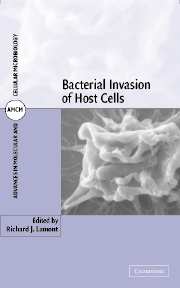Book contents
- Frontmatter
- Contents
- Contributors
- Preface
- Bacterial Invasion of Host Cells
- 1 Invasion mechanisms of Salmonella
- 2 Shigella invasion
- 3 How Yersinia escapes the host: To Yop or not to Yop
- 4 Stealth warfare: The interactions of EPEC and EHEC with host cells
- 5 Molecular ecology and cell biology of Legionella pneumophila
- 6 Listeria monocytogenes invasion and intracellular growth
- 7 N. gonorrhoeae: The varying mechanism of pathogenesis in males and females
- 8 Group A streptococcal invasion of host cells
- 9 Invasion of oral epithelial cells by Actinobacillus actinomycetemcomitans
- 10 Invasion by Porphyromonas gingivalis
- Index
- Plate section
- References
5 - Molecular ecology and cell biology of Legionella pneumophila
Published online by Cambridge University Press: 21 August 2009
- Frontmatter
- Contents
- Contributors
- Preface
- Bacterial Invasion of Host Cells
- 1 Invasion mechanisms of Salmonella
- 2 Shigella invasion
- 3 How Yersinia escapes the host: To Yop or not to Yop
- 4 Stealth warfare: The interactions of EPEC and EHEC with host cells
- 5 Molecular ecology and cell biology of Legionella pneumophila
- 6 Listeria monocytogenes invasion and intracellular growth
- 7 N. gonorrhoeae: The varying mechanism of pathogenesis in males and females
- 8 Group A streptococcal invasion of host cells
- 9 Invasion of oral epithelial cells by Actinobacillus actinomycetemcomitans
- 10 Invasion by Porphyromonas gingivalis
- Index
- Plate section
- References
Summary
Legionella pneumophila, a Gram-negative bacillus that is ubiquitous in aquatic environments, is responsible for Legionnaires' disease. It is a facultative intracellular pathogen that can replicate within eukaryotic host cells such as protozoan and macrophages. In water, L. pneumophila grows within protozoan hosts. There are at least 13 species of amoebae and 2 species of ciliated protozoa that support intracellular replication of L. pneumophila (Fields, 1996). Among the most predominant amoebae in water sources are hartmannellae and acanthamoebae, which have also been isolated from water sources associated with Legionnaires' disease outbreaks (Fields, 1996). Interaction between L. pneumophila and protozoa is considered to be central to the pathogenesis and ecology of L. pneumophila (Rowbotham, 1986; Harb et al., 2000). In humans, L. pneumophila reaches the lungs after inhalation of contaminated aerosol droplets (Fields, 1996; Fliermans, 1996; also see Fig. 5.1). The main sources of contaminated water droplets are hot water and air-conditioning systems, but the bacteria have been isolated from fountains, spas, pools, dental and hospital units, and other man-made water systems (Fliermans, 1996; also see Fig. 5.1). No person-to-person transmission has been described. Once in the lungs, L. pneumophila are ingested in alveolar macrophages, the major site of bacterial replication. This results in an acute and severe pneumonia. In addition to Legionnaires' disease, L. pneumophila also causes Pontiac fever, which is a self-limiting flu-like illness that is not well understood but is not lethal. Approximately one half of the 48 species of Legionella have been associated with human disease.
- Type
- Chapter
- Information
- Bacterial Invasion of Host Cells , pp. 123 - 160Publisher: Cambridge University PressPrint publication year: 2004



